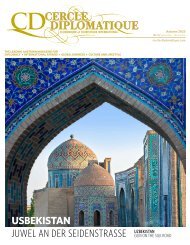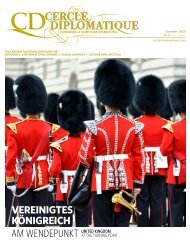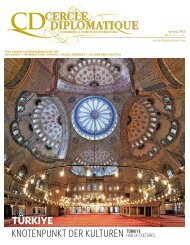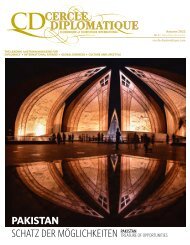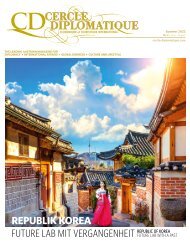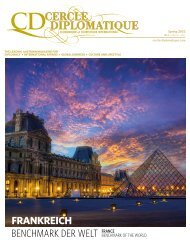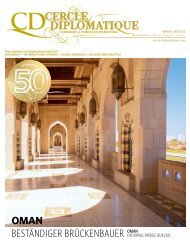CERCLE DIPLOMATIQUE - issue 01/2016
CD is an independent and impartial magazine and is the medium of communication between foreign representatives of international and UN-organisations based in Vienna and the Austrian political classes, business, culture and tourism. CD features up-to-date information about and for the diplomatic corps, international organisations, society, politics, business, tourism, fashion and culture. Furthermore CD introduces the new ambassadors in Austria and informs about designations, awards and top-events. Interviews with leading personalities, country reports from all over the world and the presentation of Austria as a host country complement the wide range oft he magazine.
CD is an independent and impartial magazine and is the medium of communication between foreign representatives of international and UN-organisations based in Vienna and the Austrian political classes, business, culture and tourism. CD features up-to-date information about and for the diplomatic corps, international organisations, society, politics, business, tourism, fashion and culture. Furthermore CD introduces the new ambassadors in Austria and informs about designations, awards and top-events. Interviews with leading personalities, country reports from all over the world and the presentation of Austria as a host country complement the wide range oft he magazine.
You also want an ePaper? Increase the reach of your titles
YUMPU automatically turns print PDFs into web optimized ePapers that Google loves.
LE MONDE PROMOTION<br />
Celebrating Europe Day and Europe‘s Flag<br />
„Against the blue sky of the Western world, the stars represent the peoples<br />
of Europe in a circle, a symbol of unity. Their number shall be invariably set<br />
at twelve, the symbol of completeness and perfection.“<br />
EU-flags in front of the Berlaymont-Building at rue de la Loi/Wetstraat, Brussels, the<br />
European Commission headquarters.<br />
You will encounter it every day and almost<br />
everywhere: in front of public buildings, in<br />
your passport, on Euro-notes and on the license<br />
plate of your car. It is even hidden amongst the<br />
emojis available on your smartphone: the European<br />
flag. Today, the circle of twelve golden stars on dark<br />
blue background is widely recognised as the sign of<br />
the European Union – even beyond its own borders.<br />
This year‘s Europe Day, the 9th of May, there is a special<br />
occasion for celebrating: 2<strong>01</strong>6 marks the 30th<br />
anniversary of the European flag as the symbol of the<br />
European Union.<br />
Originally, the 12-starred flag had exclusively<br />
been the symbol of the Council of Europe, an international<br />
organisation of, today, 47 member states<br />
which is promoting human rights and democracy. It<br />
was only in 1986 when the European Community,<br />
predecessor of the European Union, adopted the<br />
same flag, too.<br />
In the 1950s, the Council of<br />
Europe was looking for a symbol<br />
that would be representative,<br />
unifying and recognizable in order<br />
to spread the message of European<br />
cooperation in a postwar<br />
continent. French painter<br />
Arsène Heitz, an employee of the<br />
Council‘s postal office, submitted<br />
numerous sketches for a flag design.<br />
Among those submissions<br />
one stood out: a flag with fifteen<br />
golden stars (one for every<br />
Council member state of the<br />
time), arranged in a circle, on an<br />
azure blue background. The design<br />
was unanimously accepted.<br />
Finally, however, it was decided<br />
not to link the stars to the number<br />
of member states at all but to<br />
incorporate twelve stars instead,<br />
the symbol of „completeness and<br />
perfection“ in European cultural<br />
history.<br />
On the other hand, the European Communities<br />
– the EU‘s predecessor – never had its generally accepted<br />
official symbol or flag. Therefore, a big green<br />
E on white ground was often used for that purpose. It<br />
required an initiative from the members of the European<br />
Parliament – the directly elected legislative<br />
body of what is now the European Union: They wanted<br />
to highlight the continent‘s new found cooperation<br />
and to settle the question of the emblem once and<br />
for all. After broad approval in the parliament as well<br />
as after receiving permission from the Council of Europe,<br />
the flag of the latter was adopted: on 29 May<br />
1986, the circle of twelve golden stars on the blue<br />
background flew outside the European Commission<br />
building in Brussels for the first time. Today, the European<br />
flag has become the definitive symbol for the<br />
European Union, for Europe and for democracy. It<br />
stands for a union of European countries working<br />
together in cooperation, solidarity and unity, as envisioned<br />
by Robert Schuman.<br />
INFO<br />
On May 9th, Europeans<br />
commemorate the<br />
declaration by French<br />
foreign minister Robert<br />
Schuman who, in 1950,<br />
called for a common<br />
European Coal and Steel<br />
Community, a project that<br />
would eventually develop<br />
into the European Union<br />
we know today. The<br />
common project was<br />
initiated in the wake of<br />
World War II to ensure<br />
that another war between<br />
European nations would<br />
be „not merely<br />
unthinkable, but<br />
materially impossible“.<br />
PHOTO: © EUROPEAN UNION, 2<strong>01</strong>6, ETIENNE ANSOTTE<br />
L'AUTRICHE<br />
DER NAME IST<br />
PROGRAMM. IN<br />
L’AUTRICHE DREHT SICH<br />
ALLES UM DEN STANDORT<br />
ÖSTERREICH, SEINE<br />
WIRTSCHAFT UND SEINE<br />
BEDEUTUNG AUF DEM<br />
INTERNATIONALEN<br />
PARKETT.<br />
THE NAME SAYS IT ALL.<br />
IN L’AUTRICHE THE FOCUS IS<br />
ON AUSTRIA, ITS ECONOMY<br />
AND ITS ROLE ON THE<br />
INTERNATIONAL STAGE.<br />
Vertretung der EU-Kommision in Österreich<br />
Sie finden uns auf Facebook und Twitter<br />
http://ec.europa.eu/austria/index_de.htm<br />
https://www.facebook.com/ekoesterreich<br />
https://twitter.com/EUKommWien<br />
56 Cercle Diplomatique 1/2<strong>01</strong>6





